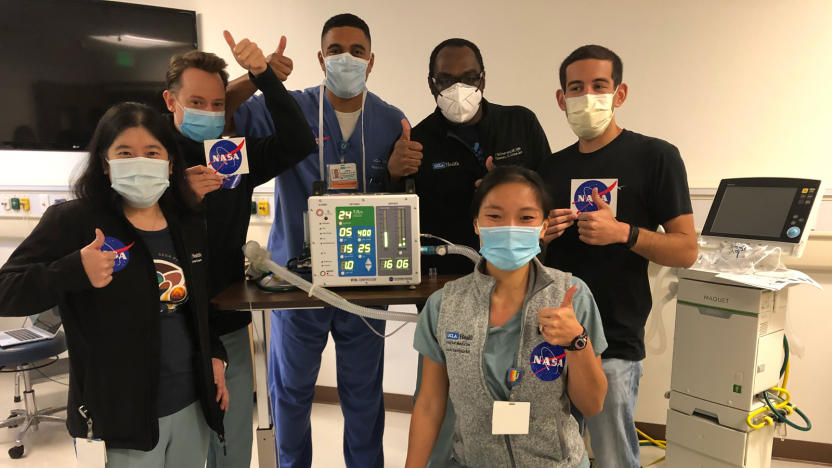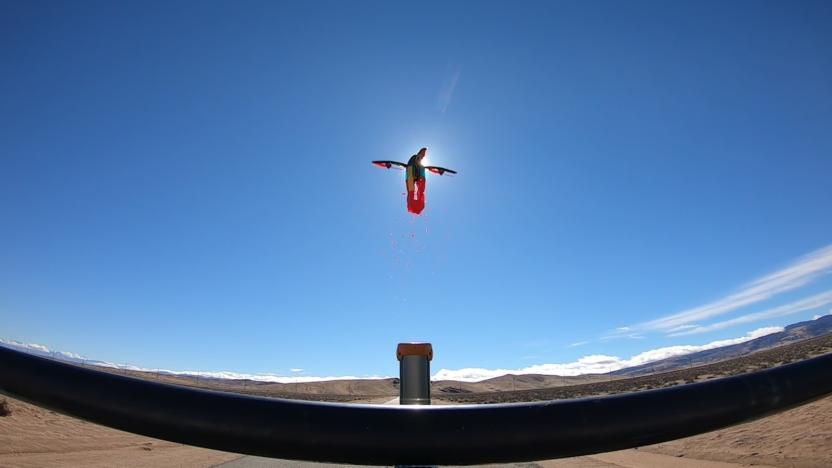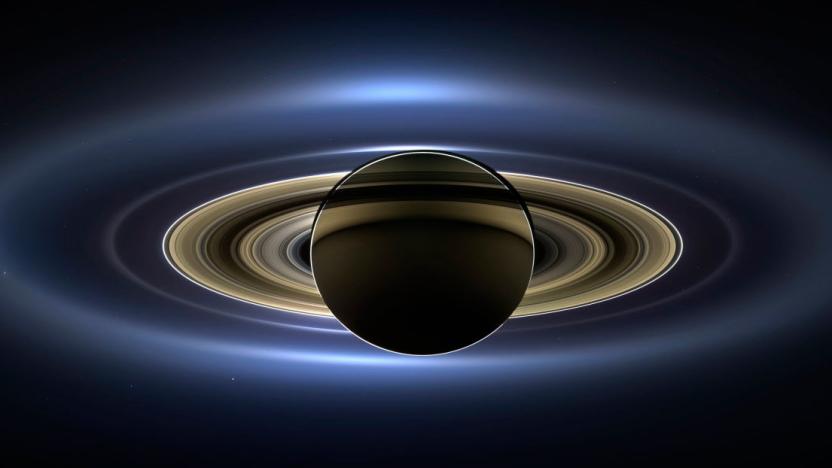jet propulsion laboratory
Latest

NASA made a necklace that reminds you not to touch your face
You can make your own Pulse with a few parts and a 3D-printed case.

Eight US companies will manufacture NASA’s COVID-19 ventilator
Eight US companies will manufacture the ventilator designed by NASA's Jet Propulsion Laboratory and fast-tracked by the FDA.

Watch a 'transforming' drone blast out of a cannon
Researchers launched a drone from a pneumatic baseball pitching machine strapped to a truck traveling 50 miles per hour. They hope this ballistic launch method might lead to drones that are better suited for emergency response and space exploration missions.

How NASA will defend the Earth against plagues from outer space
In the summer of 1957, the Earth stood witness as a meteorite cratered in rural Pennsylvania, bringing with it a people-eating plague never seen: an alien amoeba with the taste for human flesh. While we had Steve McQueen around for the first invasion, humanity is now defended against microbial marauders from outer space by NASA and its international counterparts.

A lawsuit almost stalled NASA's Cassini mission
Capt. Scott Kelly wasn't kidding when he famously quipped that "space is hard." Even getting to the launch pad can prove to be a daunting challenge. Take the Cassini mission to study Saturn, for example. Despite an investment of $3.4 billion and nearly a decade of development, Cassini wound up being very nearly scuttled at the last minute by protesters who thought they knew better than a federal agency that has put multiple men on the moon. Geez guys, it was just 73 pounds of plutonium riding aboard that Saturn orbiter -- it wouldn't have caused that much damage had something gone horribly wrong at launch.

Prototype NASA rover can ride on the underside of frozen lakes
We've built rovers to deal with arid planets like Mars, but what about trips to Titan's hydrocarbon puddles and Europa's ice lakes? NASA's Jet Propulsion Laboratory is working on a robot that'll dive into the frozen water, riding along the underside of the surface of Jupiter's moon. BRUIE (Buoyant Rover for Under-Ice Exploration) is currently being tested out in the Alaskan wilderness, not only to determine if such technology could work, but also to study the water itself, measuring its salt content and temperature. If all goes well, then the first tentative steps towards a launch could begin in a few decades, but until then, you can catch BRUIE in action in the video below.

Deezmaker 3D Printer Store opens in Pasadena, will sell you a slice of the future for $600
If the MakerBot store in Manhattan is the East coast's vanguard for 3D printer stores, Deezmaker's just-opened store in Pasadena, California is the equivalent pioneer for the West coast crew. As of now, you can walk through the doors at 290 North Hill Avenue and at least see the store's own Bukobot printer in action, even if high demand through Kickstarter pre-orders precludes walk-in sales for the next few weeks. When you can make that impulse purchase, however, you'll find the Bukobot at a relatively cheap $600 and may see some alternatives during your visit. Store owner and Bukobot creator Diego Porqueras stresses to Ars Technica that he wants Deezmaker lasting for the long haul, and he may have chosen just the right area to make that happen -- the shop is a stone's throw from the experimenters (and simply curious) at Caltech, NASA's JPL and Pasadena City College. No matter how it all shakes out, we're hoping that the two near-simultaneous store openings are the start of a larger trend that takes 3D printing into the mainstream.

NASA InSight tapped for Mars drilling mission in 2016
The surface of Mars? Psh... been there. With the Curiosity stage well under way, our exploration of the Red Planet is about to take a dive beneath the dust. Interior Exploration using Seismic Investigations, Geodesy and Heat Transport -- InSight, for short -- was just confirmed as a new NASA mission, with the space agency set to launch in March of 2016. Based on the Phoenix lander, the craft is tasked with giving us a peek beneath the planet's surface, armed with tools that include a geodetic instrument from the Jet Propulsion Laboratory, which will be used to calculate Mars' rotation axis, a seismic wave sensor and a subsurface heat probe, to measure the planet's internal temperature. The program has a $425 million budget -- a bit shy of the $2.5 billion allocated for Curiosity -- not including the costly launch vehicle. NASA Administrator Charles Bolden said that InSight will help pave the way for future human missions to Mars, and represents just one of the related projects to come. Hit up the source link below for a closer look at JPL's latest endeavor.

NASA's Curiosity rover receives long-distance OTA update, 'brain transplant' on Mars
Think it's nifty when your carrier deigns to provide your smartphone with that long awaited OTA update? That's nothing. Over the weekend, NASA's Curiosity rover will be receiving its first long-distance OTA update -- all the way out there on Mars. The goal is to transition both redundant main computers from software suited for landing the vehicle to software optimized for surface exploration -- such as driving, obstacle avoidance and using the robotic arm. NASA calls it a "brain transplant" and points out that the software was actually uploaded during the flight from Earth. Now can someone please enable OTA downloads for the human brain? We'd really like to know kung fu. PR after the break.

NASA's Curiosity Mars landing successful, first pictures trickling in (video)
After "seven minutes of terror" involving guided entry, parachute and powered descent, and even a sky crane, NASA's Curiosity rover has successfully touched down on the surface of Mars. Better yet, the 2,000lbs (900kg) science lab has established communications with Earth and is sending back telemetry along with the first pictures of Gale crater. These initial grayscale images are only 256 x 256 pixels in size but show Curiosity's shadow on the Martian soil. Peek at our galley below and stay tuned for updates. Update: Hit the break to check out a video of all the "seven minutes of terror" highlights. %Gallery-161818%

NASA's GRAIL spacecrafts enter Moon's orbit, set to map its gravitational field in March
Way back in September, NASA's Jet Propulsion Laboratory sent a duo of Lockheed Martin-produced spacecraft toward one of its favorite test subjects, the Moon, as a part of its GRAIL mission -- Gravity Recovery And Interior Laboratory. Now, nearly four months later, the administration has announced that the GRAIL-A and -B twin crafts have planted themselves within our Moon's orbit. According to NASA, they're currently in "a near-polar, elliptical orbit with an orbital period of approximately 11.5 hours," and it plans to execute more "burn maneuvers" in the coming weeks to shorten that time frame to less than two. By March, the research crafts will be positioned in a "near-polar, near-circular orbit" 34 miles above its surface, at which point they'll begin surveying its gravitational pull, by using radio signals to determine the distance between both units. With this information, NASA hopes to better understand how gravity works, both above and below the Moon's surface, by detailing the findings in a high-resolution map. NASA also says that scientists can utilize it to get further insight into how our planets formed. Notably, both spacecraft feature a MoonKAM (Moon Knowledge Acquired by Middle school students), that will allow students request pictures of specific areas the lunar surface for later study. Best of all, using NASA's "Eyes on the Solar System" web app, you'll be able to follow the paths of both spaceships in detail. You'll find full details about the GRAIL mission at the source links below.

NASA looks to send landers to Europa in 2020, wants to break the ice
There's still a lot of mystery surrounding Jupiter's moon Europa, but researchers at NASA seem fairly certain that there's a watery ocean lurking beneath its icy exterior. Their theories may finally be put to the test later this decade, thanks to a concept mission crafted by astronomers at the Jet Propulsion Laboratory. According to Space.com, JPL researchers have come up with a plan that would send a pair of landers to Europa by 2026, in the hopes of finding out whether the rock has ever supported life forms. The endeavor certainly wouldn't be easy, since Jupiter blankets its moon in heavy radiation, but researchers think they can mitigate these risks by sending in an extra lander as backup, and by keeping the mission short and sweet. Under the plan, each 700-pound robot would use a mass spectrometer, seismometers and a slew of cameras to search for any organic chemicals that may be lodged within the moon's ice. Neither craft will sport a protective shield, so they'll only stay around the planet for about seven days, so as to avoid any radiation damage. At this point, the mission is still in the concept phase, though the JPL is hoping to launch both landers by 2020. JPL researcher Kevin Hand was quick to point out, however, that this would be a "habitability mission," and that NASA doesn't expect to find any signs of current life on Europa. Lars von Trier was unavailable for comment.

NASA animation depicts Curiosity's soft landing on Mars, courtesy of a 'sky crane' (video)
Sending a rover to a distant planet is no small feat, so we might as well make the landing even more spectacular, right? That's exactly what NASA has in mind for its Curiosity Mars rover, albeit for more practical reasons. Launching in late 2011 and expected to land on Mars in August 2012, this mobile laboratory will see a unique descent after entering the Martian atmosphere: there'll be the usual separation from the heatshield and backshell, but at about 380 seconds into the entry, the rover will be gently lowered down by wire from a "sky crane," as opposed to taking a leap of faith. Once the landing is complete, the hovering sky crane will then detach from the rover and fly off for a dramatic disposal -- let's just hope it won't hit the now-dormant Spirit. See for yourself in the video above.

Watch the next Mars rover being built... via USTREAM! (video)
Does the idea of live video from JPL, where NASA's best and brightest are assembling the next Mars Rover, promise excitement and adventure? Perhaps not entirely. Are we holding out for a little more than some guys in clean suits gazing thoughtfully at the thing for minutes on end? Yes we are. You know as well as anybody how much we love our civilian space program, and how giddy with excitement we tend to get whenever they announce some new technology, so we're wishing everyone involved much success with this latest endeavor. And we're really hoping that things pick up a little on the USTREAM. As for the rover itself, it's called Curiosity, and it should launch a year or so from now, putting it on the red planet sometime in August 2012. Get a good look after the break.

NASA's robot submarine achieves perpetual motion, of a sort
The Sounding Oceanographic Lagrangrian Observer Thermal Recharging (SOLO-TREC) autonomous underwater vehicle is, well, quite a mouthful. It's also the first submarine that can run a sizable percentage of forever without requiring a charge. When the 183-pound buoy dives, cooler water temperature causes a liquid wax-like substance inside to solidify, squeezing out oil that drives a hydraulic generator; when it surfaces, the wax softens once again, ready for another round. Every dive produces 1.7 watt-hours of electricity, enough to power all the instruments, GPS and buoyancy-control pump on board. It's like a drinking bird that never runs out of water. Designed by NASA's Jet Propulsion Laboratory and Scripps researchers, the thermal engine is envisioned as an oceanography tool... but since the US Navy also has a finger in the pie, don't be surprised if it plays a minor role in the coming robot apocalypse as well.

Interplanetary internet proposed by Jet Propulsion Laboratory engineer
We'll admit, we were admittedly metagrabolised after hearing that the US military wanted to launch a router into space, but now clarity is upon us. According to Vinton Cerf and a team of diligent engineers at the California-based Jet Propulsion Laboratory, standards for space communications could be established in just three short years, meaning that an "interplanetary internet" could be just around the bend. Cerf reckons that such a system would allow Earthlings to "access information and to control experiments taking place far away" from our planet, and in the distant future, there could even be an "interplanetary backbone [erected] to assist robotic and manned missions with robust communication." And while there's no mention of setting up galactic ISPs, we're pretty certain that lonely Martians would pay a pretty penny for quasi-reliable broadband access.[Via TGDaily]










